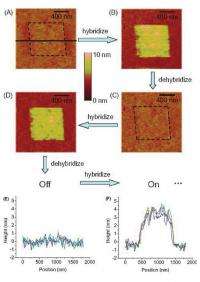January 23, 2012 feature
DNA as invisible ink can reversibly hide patterns

(PhysOrg.com) -- While most people know of DNA as the building blocks of life, these large molecules also have potential applications in areas such as biosensing, nanoparticle assembly, and building supramolecular structures. And now scientists have added another use to the list: invisible ink.
The researchers, Jian Liang and Giacinto Scoles from Temple University in Philadelphia, Pennsylvania, and Matteo Castronovo from Temple University and CRO-National Center Institute in Aviano Pordenone, Italy, have published their work on using DNA as invisible ink in a recent issue of the Journal of the American Chemical Society.
To write with DNA as invisible ink, the scientists used a nanolithography technique called nanografting, in which nanostructures are written using an atomic force microscope. Unlike other nanolithography techniques, in which nanostructures are written on top of a surface, nanografting first removes the original molecules in the scanning region and then writes new molecules in their place.
Using this technique, the scientists first covered a gold surface with a monolayer of thiolated single-stranded DNA (ssDNA) molecules using a self-assembly process. Then they embedded the same type of DNA using nanografting into the thiolated DNA background. At this point, the nanografted DNA pattern is invisible, as it has the same thickness and chemical makeup as the background.
However, the nanografted DNA is different from the self-assembled DNA background in that the nanografted molecules have a tighter packing order. Although the packing order is invisible under the initial conditions, a tighter packing order makes the nanografted DNA more sensitive to hybridization. The scientists found that performing a hybridization process that involves immersing the DNA film in a fluid containing the complementary DNA (cDNA) increases the thickness of the nanografted DNA much more dramatically than that of the self-assembled DNA. As a result, the nanografted DNA pattern emerges and becomes visible.
By dehybridizing the DNA film, the researchers could reverse the thickness increase and make the DNA pattern invisible again. To dehybridize, the researchers incubated the DNA film in ultrapure Milli-Q water for several hours, and the pattern disappeared. The researchers found that they could repeat the hybridization/dehybridization process multiple times, and the pattern could still be switched between visible (“on”) and invisible (“off”) with high fidelity.
The scientists noted that this ability to write, read, and erase is not very common in nanolithography. This novelty makes the DNA invisible ink an intriguing discovery that could be used for manipulating biological molecules and generating new encryption technologies. The encryption ability could also be combined with other techniques such as DNA stamping, which allows patterns to be transferred using a programmable, reversible, and recyclable mold.
More information: Jian Liang, et al. “DNA as Invisible Ink for AFM Nanolithography.” Journal of the American Chemical Society. DOI:10.1021/ja2076845
Journal information: Journal of the American Chemical Society
Copyright 2012 PhysOrg.com.
All rights reserved. This material may not be published, broadcast, rewritten or redistributed in whole or part without the express written permission of PhysOrg.com.


















